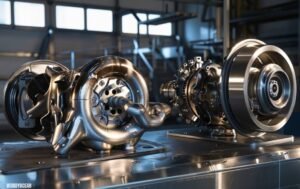Revolutionary Kamaro Robots: Enhancing Efficiency

Imagine a world where machines, once tools in human hands, become intelligent companions, capable of performing tasks with precision and efficiency far surpassing human capabilities. This vision is rapidly becoming a reality, thanks to the emergence of advanced robotic technologies like Kamaro robots.
Kamaro robots are state-of-the-art robotic systems designed to revolutionize industries across the globe. They are characterized by their advanced artificial intelligence, sophisticated sensors, and dexterous manipulators. These robots are not mere machines; they are intelligent agents capable of learning, adapting, and making decisions in real-time.
Kamaro robots offer a plethora of advantages that can significantly impact various sectors. Their precision and consistency ensure high-quality output, while their tireless work ethic boosts productivity. By automating repetitive and hazardous tasks, Kamaro robots enhance workplace safety and reduce the risk of human error.
Moreover, these robots are highly adaptable, capable of performing a wide range of tasks, from intricate assembly line operations to delicate surgical procedures. Their ability to learn and improve over time makes them invaluable assets in industries that demand continuous innovation and efficiency.
Understanding Kamaro Robots
Kamaro robots are a cutting-edge innovation in robotics, designed to revolutionize industries and enhance human capabilities. At their core, they are sophisticated machines equipped with advanced sensors, powerful actuators, and intelligent software. These components work in harmony to enable Kamaro robots to perceive their environment, make informed decisions, and execute precise movements.
One of the defining features of it is their advanced sensor systems. These sensors allow them to accurately perceive their surroundings, including visual data, depth information, and tactile feedback. With this heightened awareness, it can navigate complex environments, identify objects, and interact with their surroundings with remarkable precision.
Equally impressive are the powerful robotic arms and grippers that equip Kamaro robots. These mechanical limbs are capable of performing a wide range of tasks, from delicate assembly operations to heavy-duty material handling. Their strength, dexterity, and adaptability make them versatile tools in various industrial and service applications.
Underpinning the capabilities of it is their intelligent software and AI algorithms. These systems enable them to learn from experience, optimize their performance, and adapt to changing conditions. By integrating with other technologies like IoT and cloud computing, Kamaro robots can access vast amounts of data and collaborate with other machines and systems.
Types of Kamaro Robots
Kamaro robots come in diverse forms, each tailored to specific applications. Industrial Kamaro robots, for instance, are commonly used in manufacturing settings to automate assembly line tasks, material handling, and quality control. These robots are known for their speed, accuracy, and reliability, significantly improving productivity and reducing production costs.
In the healthcare sector, it plays a crucial role in surgical procedures, rehabilitation therapy, and drug delivery. Surgical robots, equipped with advanced imaging systems and precise robotic arms, assist surgeons in performing complex operations with minimal invasiveness. Rehabilitation robots, on the other hand, help patients recover from injuries and regain mobility through guided exercises and therapy.
Beyond industrial and medical applications, they are also finding their way into the service industry. They can be deployed in hospitality, retail, and logistics to enhance customer experiences, streamline operations, and improve efficiency. For example, robotic bartenders can mix cocktails with precision, while delivery robots can transport goods autonomously.
Real-World Applications of Kamaro Robots
They are reshaping the landscape of industrial automation. In manufacturing facilities, these intelligent machines are taking on a wide range of tasks, from intricate assembly to heavy-duty material handling. By automating repetitive and labor-intensive processes, it enhances efficiency, reduces production costs, and improves product quality.
One of the most prominent applications of it in industrial settings is assembly line automation. These robots can precisely assemble components, ensuring accuracy and consistency. This not only accelerates production but also minimizes human error, leading to higher product quality and reduced waste.
Moreover, Kamaro robots play a crucial role in material handling tasks. They can transport heavy loads, stack pallets, and move materials between workstations, freeing up human workers to focus on more complex and strategic activities. Additionally, these robots can be equipped with advanced vision systems to perform quality control inspections, identifying defects and inconsistencies in products.
Healthcare and Medicine
The healthcare industry is another sector that is benefiting from the advancements in Kamaro robot technology. In surgical procedures, robotic systems assist surgeons with greater precision and dexterity, leading to less invasive surgeries, faster recovery times, and improved patient outcomes.
Beyond surgical applications, Kamaro robots are also making significant contributions to patient care. They can deliver medications, assist with physical therapy, and provide companionship to elderly or disabled individuals. Furthermore, these robots are being used in medical research to conduct experiments, analyze data, and develop new treatments.
Service Industry
They are not limited to industrial and medical settings. They are also making inroads into the service industry, transforming the way businesses operate and interact with customers. In the hospitality sector, robotic bartenders can mix cocktails with precision, while robotic waiters can efficiently serve food and beverages.
Retail stores are also leveraging the capabilities of it to enhance customer experiences. These robots can provide product information, guide customers through stores, and even assist with checkout processes. Additionally, they can be used to automate inventory management and restocking tasks, improving operational efficiency.
In logistics and warehousing, Kamaro robots are streamlining operations by automating tasks such as order picking, packing, and shipping. These robots can navigate complex warehouse layouts, locate items, and accurately fulfill orders, reducing labor costs and increasing productivity.
The Future of Kamaro Robots
The field of robotics is rapidly evolving, and Kamaro robots are at the forefront of this technological revolution. Advancements in artificial intelligence, machine learning, and sensor technology are continually pushing the boundaries of what is possible. As these technologies mature, we can expect to see Kamaro robots become even more sophisticated and versatile.
One exciting trend is the development of collaborative robots, or cobots, which work alongside human workers in a safe and efficient manner. These robots can assist with tasks that are repetitive, dangerous, or require precision, enhancing productivity and job satisfaction.
Another promising area of development is autonomous robots, which can operate independently without human intervention. These robots have the potential to revolutionize industries such as logistics, agriculture, and construction. By automating tasks and reducing the need for human labor, autonomous robots can improve efficiency and reduce costs.
As it becomes increasingly integrated into our lives, it is essential to consider the ethical implications of their deployment. Questions arise about job displacement, privacy concerns, and the potential for misuse of these powerful technologies.
To mitigate these risks, it is crucial to develop ethical guidelines and regulations that govern the development and use of robots. Additionally, it is important to invest in education and training programs to prepare the workforce for the changing job landscape.
Overcoming Challenges and Limitations
While it offers significant benefits, they also face certain challenges and limitations. One of the primary challenges is the development of robust and reliable software and hardware systems. As robots become more complex, the risk of malfunctions and failures increases.
Another challenge is the cost of developing and deploying robotic systems. While the initial investment may be high, the long-term benefits, such as increased productivity and reduced labor costs, can outweigh the upfront expenses.
To overcome these challenges, researchers and engineers are working to develop more affordable and reliable robotic components. Additionally, advancements in AI and machine learning are enabling robots to learn and adapt to new situations, improving their overall performance.
Conclusion
In conclusion,it represents a significant leap forward in robotics technology. Their advanced capabilities, versatility, and potential for positive impact across various industries make them a force to be reckoned with. From automating manufacturing processes to assisting in healthcare and revolutionizing the service industry, Kamaro robots are poised to reshape our world.
As we look to the future, it is clear that It will continue to evolve, driven by advancements in artificial intelligence, machine learning, and robotics. By addressing ethical concerns and overcoming technical challenges, we can harness the power of these intelligent machines to create a brighter future for humanity.
To learn more about IT and their potential applications, we encourage you to visit the official website or contact a local distributor. By staying informed and embracing innovation, we can unlock the full potential of this groundbreaking technology.
FAQs: Kamaro Robots
Q: What are Kamaro Robots?
A: Kamaro robots are advanced robotic systems designed to enhance efficiency, productivity, and safety across various industries. They possess advanced AI, sophisticated sensors, and dexterous manipulators, enabling them to perform complex tasks with precision.
Q: What are the key features and capabilities of Kamaro Robots?
A: Kamaro robots are equipped with advanced sensor systems that allow them to accurately perceive their environment. Powerful robotic arms and grippers enable them to perform a wide range of tasks. Intelligent software and AI algorithms empower them to learn, adapt, and make informed decisions. Additionally, they can integrate with various technologies like IoT and cloud computing.
Q: What are the different types of Kamaro Robots?
A: Kamaro robots come in diverse forms, each tailored to specific applications. Industrial Kamaro robots are used in manufacturing for assembly line automation, material handling, and quality control. In healthcare, they assist in surgical procedures, rehabilitation therapy, and drug delivery. Service industry Kamaro robots are employed in hospitality, retail, and logistics for tasks like serving food, guiding customers, and automating warehouse operations.
Q: How are Kamaro Robots revolutionizing industrial automation?
A: Kamaro robots are transforming manufacturing processes by automating repetitive tasks, improving product quality, and reducing costs. They excel in assembly line automation, material handling, and quality control inspections.








